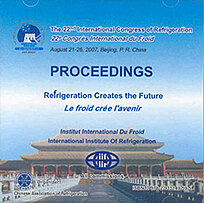
Document IIF
Effet du réchauffement sur les vaisseaux sanguins importants sur le plan thermique au sein des tissus de tumeur perfusés pendant la cryochirurgie.
Heating effect of thermally significant blood vessels in perfused tumour tissue during cryosurgery.
Auteurs : LIU Z. F., ZHAO G., HUANG Y. H., et al.
Résumé
This article focuses on the heating effects of thermally significant blood vessels during cryosurgery process. The thermal model here bases on the Pennes bio-heat transfer equation describing the heat transfer of perfused tumour tissue and the energy transport equation governing the heat convection and diffusion of the blood flow. The explicit finite different method is used to solve the transient equation for the temperature field of a perfused tumour tissue encompassing a blood vessel in 3-D configuration during cryosurgery. The second boundary condition is performed at the boundary of the blood vessels and the tissue. As a result of simulation, the thermal stability effect of the flowing blood can be seen clearly at the vicinity of the vessels. The volume of the frozen tissue in the case with the significant vessels is much smaller than that in the case without the vessels in a typical cryosurgery process. To ensure the curative effect during the cryosurgery, the significant blood vessels near the tumour is needed to be considered.
Documents disponibles
Format PDF
Pages : ICR07-C1-1515
Disponible
Prix public
20 €
Prix membre*
Gratuit
* meilleur tarif applicable selon le type d'adhésion (voir le détail des avantages des adhésions individuelles et collectives)
Détails
- Titre original : Heating effect of thermally significant blood vessels in perfused tumour tissue during cryosurgery.
- Identifiant de la fiche : 2008-0946
- Langues : Anglais
- Source : ICR 2007. Refrigeration Creates the Future. Proceedings of the 22nd IIR International Congress of Refrigeration.
- Date d'édition : 21/08/2007
Liens
Voir d'autres communications du même compte rendu (839)
Voir le compte rendu de la conférence
Indexation
- Thèmes : Cryomédecine et cryochirurgie
- Mots-clés : Transfert de chaleur; Simulation; Système sanguin; Modélisation; Cryochirurgie
-
LOW-TEMPERATURE EXPERIMENTAL RESEARCH FOR METHO...
- Auteurs : WANG H., GONG W.
- Date : 11/10/1989
- Langues : Anglais
Voir la fiche
-
CRYOTHERAPY OF PRIMARY VARICOSE VEINS OF THE LO...
- Auteurs : LE PIVERT P.
- Date : 11/10/1989
- Langues : Anglais
Voir la fiche
-
RESEARCH ABOUT THE BASIC THEORY OF CRYOSURGERY.
- Auteurs : DING H. C.
- Date : 11/10/1989
- Langues : Anglais
Voir la fiche
-
AN ANALYTICAL STUDY ON THE PROCESS OF FREEZING ...
- Auteurs : RUBINSKY B., ETO T. K., ONIK G.
- Date : 11/10/1989
- Langues : Anglais
Voir la fiche
-
Theoretical evaluation of a new thermal system ...
- Auteurs : SUN J., ZHANG A., BAI J.
- Date : 21/08/2007
- Langues : Anglais
- Source : ICR 2007. Refrigeration Creates the Future. Proceedings of the 22nd IIR International Congress of Refrigeration.
- Formats : PDF
Voir la fiche
